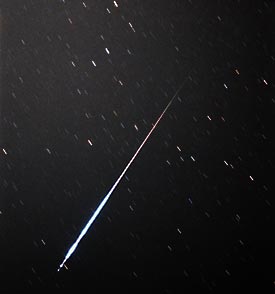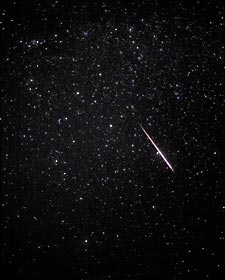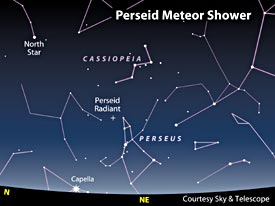August 8, 2007
Contact:
Alan MacRobert, Senior Editor
855-638-5388 x151, [email protected]
J. Kelly Beatty, Executive Editor
855-638-5388 x148, [email protected]
| Note to Editors/Producers: This release is accompanied by publication-quality illustrations and broadcast-quality animations; see details below.
More information for the general public is available at SkyandTelescope.com/Perseids. |
The Perseid meteor shower, an annual celestial event beloved by millions of skywatchers around the world, returns to the night sky this coming weekend. And with a new Moon occurring at the same time, skywatchers won't have bright moonlight spoiling the view.
Sky & Telescope magazine predicts that the Perseid shower will reach its peak late on Sunday night, August 12th. The rate of activity should pick up after midnight until the first light of dawn. "The combination of a moonless night, together with a peak timed to favor North America, means that conditions for this year's display will be ideal," notes Sky & Telescope senior editor Alan MacRobert.
To enjoy the Perseids, you'll need no equipment other than your eyes. Find a dark spot with a wide-open view of the sky. Bring a reclining lawn chair or a blanket so you can look skyward without neck strain. The later you can stay up, the more meteors you're likely to see. "Go out after about 11 or midnight or so, lie back, and gaze up at the stars," MacRobert suggests. "Relax, be patient, and let your eyes adapt to the dark. With a little luck you'll see a 'shooting star' every couple of minutes on average."
Perseids can appear anywhere and everywhere in the sky. So the best direction to watch is wherever your sky is darkest. Faint Perseids appear as tiny, quick streaks. Occasional brighter ones may sail across the heavens for several seconds and leave a brief train of glowing smoke.
Don't give up if it's cloudy Sunday night. The shower lasts for about two weeks, with satisfying displays in the predawn hours of August 10th through 15th.
HOW AND WHY
The meteors are caused by tiny, sand- to pea-size bits of dusty debris slamming into Earth's upper atmosphere about 80 miles up. Each particle zips in at 37 miles per second, creating a quick, white-hot streak of superheated air. (Note: The nuggets in Grape Nuts cereal are a close match to the estimated size, color, and texture of typical particles.)
These particles were shed long ago by Comet Swift-Tuttle and are distributed all along the comet's orbit around the Sun. Earth passes through this tenuous "river of rubble" every year in mid-August.
If you trace each meteor's direction of flight backward across the sky, you'll find that all the Perseid meteors seem to radiate outward from a spot in the constellation Perseus, near Cassiopeia. This radiant, a perspective effect, is low in the north-northeast before midnight and rises higher in the sky during the early-morning hours. Few if any Perseids can ever be seen from Southern Hemisphere countries like Australia, where this radiant is always near or below the horizon.
More about the Perseids and how to watch them appears in the August 2007 issue of Sky & Telescope magazine and at the magazine's website.
Sky & Telescope is pleased to make several publication-quality illustrations and broadcast-quality animations available to the news media. Permission is granted for one-time, nonexclusive use in print and broadcast media, as long as appropriate credits (as noted in each caption) are included. Web publication must include a link to SkyandTelescope.com.
 A bright Perseid meteor streaks across the sky on August 13, 1985. Most meteors are white, but this one began red and flared to brilliant blue-white during its 1-second-long appearance. Download a publication-quality version (8-megabyte TIFF, CMYK) by anonymous FTP. Photo by Michael Shin; courtesy Sky & Telescope. |
 A brilliant Perseid flashes across the constellation Andromeda on August 12, 1997, and a fainter meteor flares near the W of Cassiopeia (at top in full frame). Rick Scott and Joe Orman made this 8-minute exposure in Florence Junction, Arizona, using a 21-millimeter f/2 lens and Ektachrome P1600 film. Download a full-frame, publication-quality version (30-megabyte TIFF, CMYK) by anonymous FTP. Photo by Rick Scott and Joe Orman, courtesy Sky & Telescope. |
 This is a reduced-size frame from Sky & Telescope's broadcast-quality QuickTime animation (TRT 20:03) simulating the appearance of the Perseid meteor shower at 11 p.m. in mid-August. Download a publication-quality version (244-kilobyte JPEG) by anonymous FTP, or click on the following link to download the complete animation: 6-megabyte MOV. Sky & Telescope illustration and animation by Gregg Dinderman. |
 These are reduced-size frames from Sky & Telescope's broadcast-quality QuickTime animation (TRT 14:24) showing how a meteor is formed when a speck of cometary debris burns up in Earth's upper atmosphere. Download the complete animation (17-megabyte MOV) by anonymous FTP. Sky & Telescope animation by Steven A. Simpson. |
Sky Publishing (a New Track Media company) was founded in 1941 by Charles A. Federer Jr. and Helen Spence Federer, the original editors of Sky & Telescope magazine. In addition to Sky & Telescope and SkyandTelescope.com, the company publishes two annuals (Beautiful Universe and SkyWatch), as well as books, star atlases, posters, prints, globes, and other fine astronomy products.
 0
0
Comments
You must be logged in to post a comment.